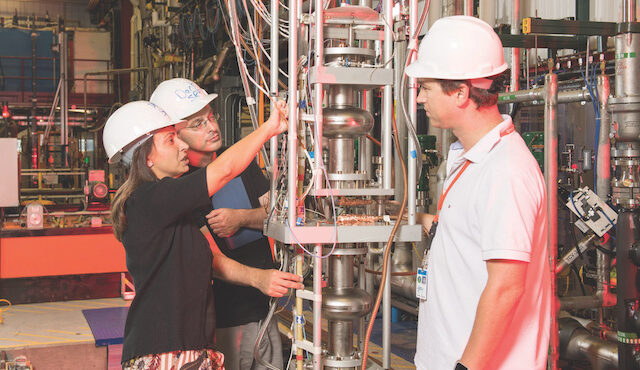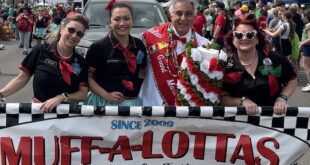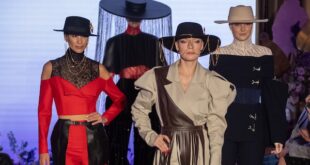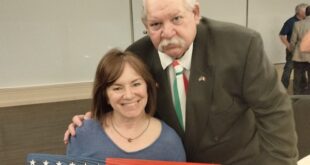A summer intern at Fermilab in Batavia in the early years of her career, Anna Grassellino now heads one of the country’s major quantum research initiatives based at the lab.
Nearly two decades ago, Anna Grassellino spent the summer as an intern at Fermilab in Batavia, Illinois, which sparked her interest in research. After rising to the top of her field, the Italian-born scientist now serves as director of the National Quantum Information Science Center at Fermilab, the same place where it all started.
Her groundbreaking research has earned her a multitude of awards, most recently the 2023 New Horizons in Physics Prize from the Breakthrough Prize Foundation.
Grassellino holds a Ph.D. in physics from the University of Pennsylvania and a master’s of electronic engineering from the University of Pisa, Italy. She spoke with Fra Noi about the roots of her passion for science, her research and her life outside of work.
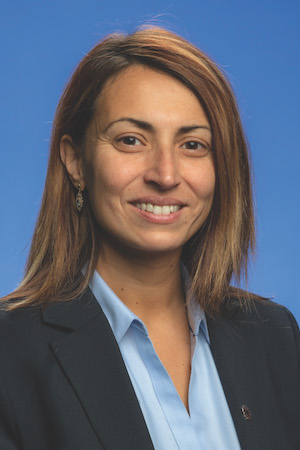 Elena Ferrarin: You serve as director of one of the five National Quantum Information Science Research Centers. What does that work consist of?
Elena Ferrarin: You serve as director of one of the five National Quantum Information Science Research Centers. What does that work consist of?
Anna Grassellino: The work consists of coordinating the work of over 500 collaborators across 30 partner institutions and ensuring execution of the SQMS Center roadmap, reaching the ambitious goals and deliverables of advancing quantum technology and delivering new science with the quantum computers and sensors that our scientists, engineers, postdocs, students and technicians are hard at work advancing, building and deploying. It involves reporting to the Department of Energy, coordinating with the directors of the other four National Quantum Centers, and interacting with national and international funding agencies to ensure maximum output and impact and advances for the national quantum initiative.
EF: You grew up in Marsala, Sicily. How did you get into science?
AG: I was very young. I watched the Disney movie “Paperino nel mondo della Matemagica” (Donald in Mathmagic Land), and it really sparked my interest in mathematics. Then, it was my teachers. My math teacher in middle school was a very tough woman, and she pushed me to have more and more interest in math.
EF: You spent summer 2004 as an intern at Fermilab. What was that like?
AG: I really fell in love with the big physics experiments they were doing, like the CDF (Collider Detector at Fermilab) experiment at the Tevatron (the world’s highest-energy proton-antiproton collider, which shut down in 2011). I was really mesmerized by the international collaboration and everybody coming together to build this ginormous experiment. My choice at that point was to get a job as an engineer or get a Ph.D. I chose the Ph.D., and they accepted me at the University of Pennsylvania.
EF: How was the transition from Italian to English for you?
AG: I had a really good background in terms of grammar and written English, and during the summer, I learned the language in the United Kingdom. But I do remember the shock of coming to the U.S. It took me some time to adjust. After six months, something in your brain clicks. Now, when I want to speak about work with Italian colleagues, I find it easier to do it in English.
EF: Your research focuses on superconducting radio frequency (SRF) cavities, and you made a groundbreaking discovery involving nitrogen doping. Could you explain that in layman’s terms?
AG: To accelerate particles, the accelerators are fitted with metallic chambers containing an electromagnetic field known as radiofrequency (RF) cavities. These cavities essentially are a perfect pendulum. They swing and never stop, and you want them to store electromagnetic energy as efficiently as possible, without any dissipating. My job is to try to battle the little bit of resistance that is left and understanding the physics behind it. Cavities is my background, and I am trying to push the boundaries. When we made that discovery (involving nitrogen), we were trying something new. Then, we realized what we had, and we made it reproducible.
EF: For your doctorate, you specialized in SRF technology and applied physics working with Nigel Lockyer, who later became the director of Fermilab. Was he an influential figure in your life?
AG: Very much so. I met Nigel for the first time during my internship at Fermilab back in 2004. That’s when I decided I wanted to come back to the States. He was looking for Ph.D. students, so I came back and did my Ph.D. at the University of Pennsylvania with Nigel. I graduated, got a job at Fermilab and, two years later, Nigel was announced as the new director. I was really fortunate to have him back. Fermilab was always strong in SRF, but we really grew a lot under Nigel.
EF: You were awarded the Presidential Early Career Award for Scientists and Engineers by President Barack Obama in 2017. What was that like?
AG: It was totally unexpected. The Department of Energy flags a small number of candidates, then the White House does its own selection. I was in the dark. I didn’t know I was nominated. First, they had to do a background check, and I remember I got a weird call about that. I was supposed to go to the White House to get the award, but unfortunately that didn’t happen. I got the award just before Obama left office. There was the Trump transition, and they never organized the ceremony.
EF: What is your life like outside of Fermilab?
AG: I have a wonderful husband, Alex Romanenko, who is also a scientist at Fermilab. We work very closely, and that, for me, is a blessing. It’s wonderful to have the opportunity to be partners in life and also at work. He has fantastic ideas; I am the one who pushes for realization. He has been really helpful for me as a woman in science, and he’s been a really good father to our three kids. We equally share parenting responsibilities.
EF: What do you think is the state of women in science?
AG: In Italy, we have a lot more women that go into physics, biology and STEM (science, technology, engineering and mathematics) than in the United States … but then we kind of lose them. Here in the U.S., we have very few women, but we are very good at putting emphasis on diversity and role modeling, so they stay. Here in the U.S., we have to work on the pipeline. Fermilab has programs starting with internships in high school that bring in up to 60% women. We have to make sure they stay in the field.
EF: What is the key to attracting young minds to science?
AG: There has to be something really ambitious and exciting and challenging to attract young, brilliant minds. That’s what we need to focus on.
EF: Any parting words?
AG: We have to be unique, and we have to never settle with the status quo. We have to push to be a frontier. I will always be very thankful and acknowledge our Department of Energy program managers, because they really make all this possible. They follow us, and they make sure everything they fund us for is successful. They really care about that.
The above appears in the December 2023 issue of the print version of Fra Noi. Our gorgeous, monthly magazine contains a veritable feast of news and views, profiles and features, entertainment and culture. To subscribe, click here.
 Fra Noi Embrace Your Inner Italian
Fra Noi Embrace Your Inner Italian


